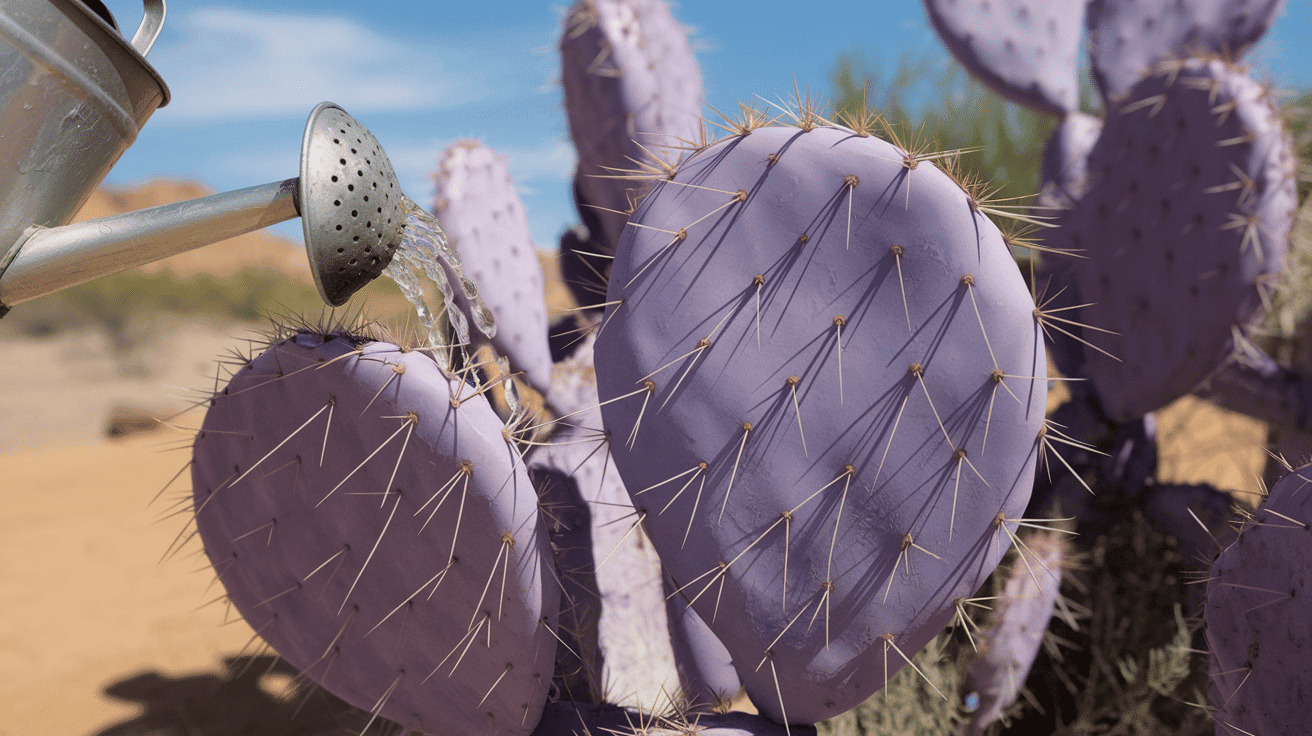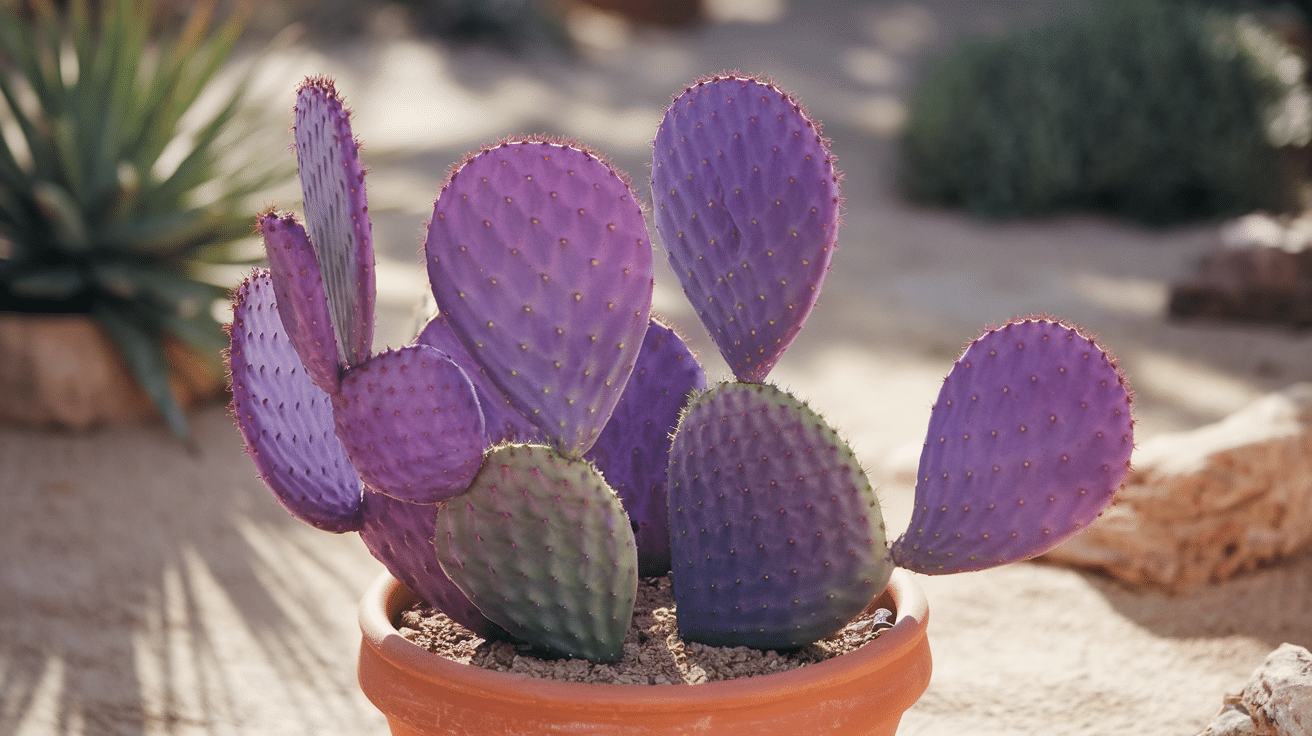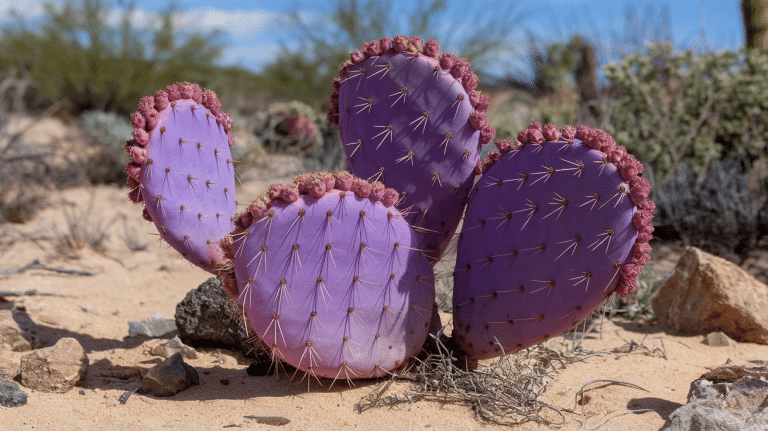Looking to add something bold and easy going to your garden? The Purple Prickly Pear (Opuntia santa-rita) might be just what you need.
With its colorful pads and no-fuss attitude, this cactus brings charm and texture without needing much in return.
It’s a great pick if you want a plant that handles heat, needs little water, and still turns heads.
In this guide, you’ll find simple care tips, ideas for where to plant it, and ways to help it thrive.
No matter your experience level, you’ll walk away with the info you need to grow and enjoy this amazing desert plant. Let’s get started.
What is Purple Prickly Pear?
Opuntia santa-rita, commonly known as Purple Prickly Pear or Santa Rita Prickly Pear, is a unique cactus native to the southwestern United States and northern Mexico.
This notable plant has flat, round to oval pads with a blue-green color that changes to rich purple during cooler weather or when under stress.
The purple color gets stronger during winter months and dry times.
The plant usually grows 3-5 feet tall and can spread 4-6 feet wide, making it a noticeable addition to desert gardens.
Native Environment
The Purple Prickly Pear thrives in the Sonoran and Chihuahuan deserts, particularly in Arizona, New Mexico, Texas, and northern Mexico.
In its natural environment, it grows in rocky, well-drained soils that receive minimal rainfall.
The climate there features hot, dry summers and mild to cool winters with occasional freezing temperatures.
This hardy cactus has adapted to survive harsh desert conditions by storing water in its thick pads and minimizing water loss through its specialized structure.
Why Gardeners Choose Purple Prickly Pear
What makes the Purple Prickly Pear special is its remarkable color-changing ability and bright yellow flowers.
Unlike many green cacti, this variety offers changing seasonal color with its purple-tinged pads that intensify during winter or drought. This provides year-round visual interest in your garden.
The plant also produces bright yellow flowers in spring, followed by red, edible fruits, making it not just ornamental but also potentially useful.
Its drought tolerance and cold hardiness (down to about 10°F or -12°C) make it perfect for water-wise landscaping in many different climate zones.
Sunlight Exposure
The Purple Prickly Pear loves sunny spots and warm temperatures.
For best growth and coloration, place it in a location that receives full sun, with at least 6-8 hours of direct sunlight daily. The more sun it gets, the more vibrant its purple hues will be.
It thrives in temperatures between 70°F and 100°F (21°C to 38°C) during the growing season but can briefly withstand higher summer temperatures and freezing winter conditions.
Strategic Placement
Your Purple Prickly Pear needs plenty of direct sunlight to stay healthy and maintain its distinctive coloration.
When grown outdoors, place it in an unshaded south or west-facing location where it will receive maximum sun exposure throughout the day.
If keeping one indoors, position it by your brightest window, typically south-facing.
Even then, these plants really prefer outdoor conditions and may never thrive as well inside as they would in a garden setting.
Understanding Temperature Tolerance
While these cacti are true sun-lovers, they can occasionally get sunburned when moved suddenly from shade to intense sun.
If you’re relocating a plant from a nursery or a partially shaded spot, introduce it gradually to full sun over a period of 1-2 weeks to prevent scorching.
Established plants rarely suffer from too much light in their natural range.
Surviving Heat Waves and Winter Frosts
Purple Prickly Pear can handle temperature extremes better than many other cacti.
It grows most actively when daytime temperatures are between 70-90°F (21-32°C).
It’s surprisingly cold-hardy for a cactus, tolerating temperatures down to about 10°F (-12°C) for brief periods, though it may show some pad damage after hard freezes.
In very cold climates (Zone 7 or below), consider planting it near a south-facing wall that will radiate heat or provide temporary protection during extreme cold snaps.
Soil Recipe
The Purple Prickly Pear needs well-draining soil to prevent root rot and ensure healthy growth.
Choose a location with sandy or gravelly soil, or create a raised bed with proper drainage.
If your natural soil is heavy clay, amend it significantly with coarse sand and gravel before planting.
For container growing, drainage holes are absolutely essential.
Best Soil Mix (DIY Recipe)
Purple Prickly Pear requires fast-draining soil that mimics its desert habitat. A good mix consists of:
- 60% coarse sand or decomposed granite
- 20% standard potting soil or garden soil
- 20% perlite, pumice, or small gravel
This mix allows water to drain quickly while still providing the minimal nutrients the cactus needs.
Avoid regular potting soil on its own, as it retains too much moisture and can lead to root rot.
The Right Type of Pot
If growing in a container, choose a pot that is wider than it is deep, as these cacti have shallow root systems.
Terra cotta or unglazed clay pots work best because they’re porous and allow soil to dry more quickly between waterings.
The pot should be just a few inches larger than the root ball – too large a container can hold excess moisture.
Most important: Make sure your pot has multiple drainage holes at the bottom.
Soil Preparation Tips
Before planting your Purple Prickly Pear, prepare the site properly:
For garden planting, dig a hole twice as wide but only as deep as the root ball. Mix in coarse sand or decomposed granite if your soil is heavy.
Create a slight mound or raised area for planting in areas with poor drainage.
Add a thin layer of gravel on top of the soil after planting to keep the base of the cactus dry and reduce weed growth.
Watering Practices: Frequency and Methods

The Purple Prickly Pear is extremely drought-tolerant and needs minimal watering once established.
For new plantings, water once every 2-3 weeks for the first few months to help establish roots. After that, rainfall alone may be sufficient in many climates.
Overwatering is the most common cause of problems with this plant, so always err on the side of too dry rather than too wet.
Water Amounts by Season
The amount of water needed changes with the seasons:
Spring (growth season): Water only when the soil is completely dry, typically every 3-4 weeks if there’s no rainfall.
Summer: Despite the heat, this is when the plant often slows growth in its native area. Water sparingly, about once a month, unless there are long heat waves.
Fall: As temperatures cool, reduce watering to once every 4-6 weeks.
Winter: In most climates, completely stop watering from late fall through winter. The plant is not actively growing and extra moisture during cold periods can cause rot.
Always check that the soil is completely dry several inches down before watering again.
Signs of Overwatering/Underwatering
Overwatered plants develop soft, discolored spots that may turn black. The pads can become waterlogged and eventually collapse or rot.
Underwatered plants show minimal distress for long periods, but eventual signs include shriveling or wrinkling of pads and a dull appearance.
Some wrinkling during long dry spells is normal and not cause for concern – the plant is simply using stored water.
When in doubt, it’s always better to underwater than overwater this desert native.
Dormancy Behavior
Purple Prickly Pear typically slows its growth during both the hottest part of summer and the cold winter months.
During these dormant periods, the plant needs very little water. In summer dormancy, the cactus may look unchanged but is conserving energy during extreme heat.
Winter dormancy is more noticeable with reduced growth and sometimes enhanced purple coloration in the pads.
Respect these natural cycles by reducing water and avoiding fertilizer during dormant periods.
Fertilizer and Nutrients Requirement of Purple Prickly Pear
The Purple Prickly Pear has modest nutrient needs and often thrives without any supplemental feeding.
If you choose to fertilize, use a diluted low-nitrogen, cactus-specific fertilizer during the spring growing season only.
Overfertilizing causes weak, oversized growth that’s more susceptible to damage and reduces the plant’s natural drought tolerance.
When to Fertilize
Purple Prickly Pear grows naturally in poor soil and requires minimal fertilizer. Many healthy specimens never receive any additional nutrients.
If you want to give your plant a slight boost, apply fertilizer only during the active growth period in spring (March- May).
Once yearly application is plenty, skip fertilizing during summer, fall, and winter when the plant is not actively growing new pads.
Best Types of Fertilizer
Use only fertilizers formulated specifically for cacti and succulents, which have lower nitrogen content. Look for ratios like 5-10-10 or 2-7-7 on the package.
Always dilute to half the recommended strength – if the label suggests one tablespoon per gallon, use only half a tablespoon instead.
Slow-release granular cactus fertilizers are a good option as they provide gradual feeding with less risk of overdoing it.
Nutrient Deficiency
Your Purple Prickly Pear rarely needs fertilizer but might benefit from a minimal feeding if:
New pads are significantly smaller than established ones despite adequate light.
The color appears yellowish rather than the typical blue-green to purple.
Always verify that light, water, and drainage conditions are optimal before assuming nutrient deficiency. Poor growth is much more commonly caused by improper watering or insufficient sunlight than by a lack of nutrients.
Flowering Cycle of Purple Prickly Pear
The Purple Prickly Pear has a distinct annual growth pattern. Understanding this cycle helps with timing care activities properly.
Spring brings the most active growth, with new pads forming. This is followed by flowering in late spring to early summer.
Fruits develop during the summer and ripen in the fall, turning deep red when mature.
Winter brings dormancy, often with enhanced purple coloration in the pads.
How to Tell if Your Plant is Growing or Resting
During active growth in spring, you’ll see new pads forming from the edges of existing ones. These start as small, thick, rounded growths that gradually flatten and widen.
When flower buds appear at the edges of pads, the plant is getting ready to bloom.
During winter rest periods, no new growth happens, and the plant looks more compact, often with stronger purple coloration.
Flower Season and Appearance
If your Purple Prickly Pear is mature and gets good care, it will bloom in late spring to early summer.
The flowers are large (2-3 inches across), bright yellow to gold, and cup-shaped with many petals. They typically last only a few days but often appear one after another over several weeks.
Flowers open fully during daylight hours and close at night, usually lasting 2-3 days before fading.
How to Collect and Grow Seeds
After flowering, green fruits develop that ripen to a deep red or purple in late summer to fall. These contain numerous small, hard seeds surrounded by sweet pulp.
To collect seeds, wear thick gloves and pick fully ripe fruits. Slice open and remove the pulp with seeds, rinse thoroughly, and allow to dry.
Plant seeds in spring in a well-draining cactus soil mix, barely covering them. Keep slightly moist until germination, which can take 2-4 weeks.
Seedlings grow very slowly and may take 3-5 years to reach a size that produces flowers.
Can It Be Propagated?
The easiest and fastest way to propagate Purple Prickly Pear is through pad cuttings:
Select a mature pad at least one year old, and using tongs and thick gloves, twist it off or cut it cleanly at the joint.
Allow the cut end to callus and dry for 1-2 weeks in a shaded, dry location.
Plant the callused end about 1-2 inches deep in a dry cactus soil mix.
Wait 2-3 weeks before giving any water, then water lightly. Roots typically form within a month.
Landscaping with Purple Prickly Pear
The dramatic color and distinctive form of Purple Prickly Pear make it a standout in desert and Mediterranean landscape designs.
Use it as a focal point in rock gardens or as part of a mixed cactus and succulent bed.
Plant it alongside other drought-tolerant species that share similar care requirements for a cohesive, low-maintenance landscape.
Companion Plants to Grow Together
Pair your Purple Prickly Pear with these compatible plants:
- Agave varieties – their rosette form looks good next to the prickly pear’s flat pads
- Yucca – tall flower stalks add height next to the spreading cactus
- Desert marigold – adds seasonal color with low water needs
- Blue grama grass – adds soft texture next to the firm cactus
- Ocotillo – its tall, thin branches work well with the lower, spreading habit of prickly pear
Choose plants that need similar water and sun to create an easy-care garden.
Ways to Use Purple Prickly Pear in Xeriscaping
- Make a focal point by planting a mature specimen among smaller succulents and decorative rocks.
- Use as a natural, living barrier or informal boundary – the spines discourage unwanted access.
- Plant along slopes or in areas difficult to irrigate, as they need minimal supplemental water once established.
- Pair with decorative gravel mulch in complementary colors like warm tan or cool gray to highlight the purple tones.
Think about how the seasonal color changes will look with permanent landscape elements throughout the year.
Health and Medicinal Benefits of Purple Prickly Pear
Beyond its ornamental value, Purple Prickly Pear offers several potential health benefits through its fruit and pads.
The fruit, called tuna, is rich in antioxidants, vitamins, and minerals. It can be eaten fresh or used in jellies, syrups, and beverages.
The young pads (nopales) are edible when prepared properly to remove spines. They’re used in many traditional Mexican dishes.
Studies suggest compounds in prickly pear may help manage blood sugar levels and reduce inflammation.
Always carefully remove all glochids (tiny hair-like spines) before handling or consuming any part of the plant.
How to Buy and Grow Purple Prickly Pear

The Purple Prickly Pear is becoming increasingly available as interest in water-wise landscaping grows.
Look for plants at:
- Local nurseries specializing in native or drought-tolerant plants
- Desert botanical garden plant sales
- Online specialty cactus and succulent retailers
When selecting a plant, look for firm, plump pads with good color and no signs of damage or pest infestation.
Getting Started with Purple Prickly Pear
To help your new Purple Prickly Pear grow well:
- Pick a planting spot with full sun and good drainage
- Mix sand or gravel into the soil if needed
- Use tongs and thick gloves to handle the plant safely
- Plant at the same depth it was growing before
- Wait 7-10 days before watering
- Give some shade from harsh afternoon sun for the first few weeks if planting in summer.
With minimal care after establishment, your Purple Prickly Pear will reward you with years of distinctive beauty and seasonal interest.
Common Problems and Solutions
Despite being low-maintenance, Purple Prickly Pear can experience several issues. Knowing how to identify and address them keeps your plant healthy.
- Overwatering is by far the most common problem, causing root rot and pad deterioration. Always let the soil dry completely between waterings.
- Cochineal scale insects sometimes appear as white, cottony patches on pads. Remove them with a strong spray of water or dab with alcohol on a cotton swab.
- Pad damage from freeze events typically heals on its own. Remove only completely dead or rotting sections.
- Sunburn from sudden exposure to intense light appears as yellow or brown patches. Provide temporary shade until the plant acclimates.
- Soft, black areas indicate rot from excessive moisture. Cut away affected parts with a clean knife, allow the wound to callus, and reduce watering.
Final Thoughts
We’ve talked about everything you need to know about the Purple Prickly Pear what it looks like, how it grows, and how to care for it.
You’ve learned how it fits into desert life and why it’s more than just something nice to look at.
If you’re looking for an easy-to-care-for plant with character, this one’s a great pick.
It fits well in dry gardens and brings something special to any space.
I hope this guide gave you clear answers and helped you feel ready to grow your own.
Now, enjoy your garden, and let it reflect a bit of you.













